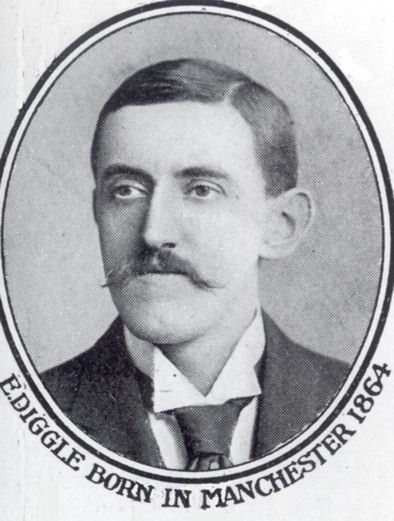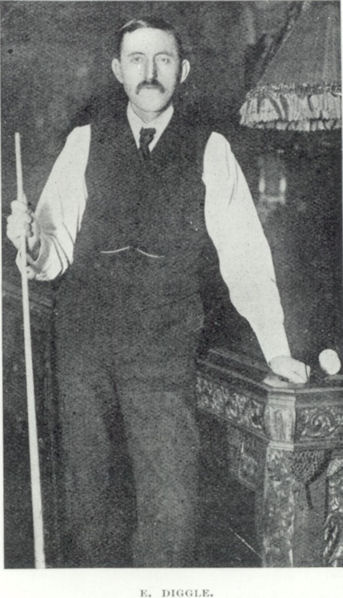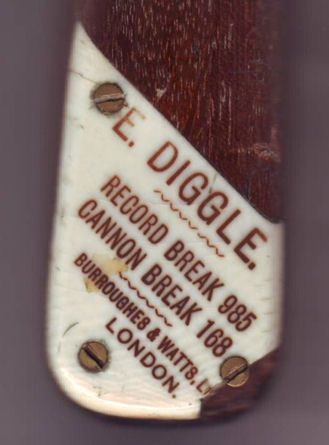E. Diggle
PAST MASTERS NO. 12 - March 1984

According to Riso Levi
- in his book entitled "Billiards in the 20th Century" Mr Edward
Diggle was nicknamed "The Mechanical Methodical Mancunian" having
being born in Manchester in January 1864, he records that he did
not begin billiards at an early age, but that as he had a Billiard
Room in Manchester he was always playing and practising, coming to
the front in 1891 when he won the Lancashire & Yorkshire
Championship by defeating Charles Dawson by 560 points in a game of
3,000 up.
Major Broadfoot in his book "Billiards" in the
Badminton Library Series published in 1896 refers to Edward Diggle
as being amongst the young players who have come most prominently
to the front since 1888 and indeed goes on to say that Diggle is
generally regarded as the most promising, but that he is not a
pretty player and does not appear to have the least idea of making
a bridge, sometimes playing through his forefinger and sometimes
between his first and second finger and in various other
extraordinary fashions - but keeps on scoring.
Another writer, George Reid, also recorded that
Edward Diggle was a very great player, but just about the "Queerest
Fish" ever known in high grade billiards. Tall lean and taciturn to
an unusual degree for a billiard player "Teddie" flouted nearly the
whole of the accepted playing standards and yet retained for more
years than one cares to count, his position amongst the elite. He
had no bridge, no stance and a cue delivery that was a cross
between a "poke" and a "shove", with both legs bent or sagging at
the knees and his left hand laid flat on the cloth. Extra ordinary,
but all you could get out of "Teddie" when you asked questions was
a drawling Lancashire reply of "Aye, Billiards is a funny game".
Walter Lindrum is reported as saying - during an interview on his
return to Australia back in 1912 - "Diggle and Harverson are fine
players - the former especially although most unconventional in his
methods".
In the "Sportsman" of 19th February 1896 there
was a report concerning a letter published in "The Times" and
signed by John Roberts (Champion), C. Dawson and E. Diggle in which
these three players - who were clearly looked upon as leading
professionals of that period defended the "Push Stoke" in the
following strong words …"Sir, we have observed that in some reports
of Billiards Matches which have appeared of late in one of the
Sporting Newspapers, the push shot is described as a "Foul Shot" …
as is well known the stroke has been played and allowed for many
years and it seems to us it cannot properly be called a foul whilst
the existing rules are in force … We utterly decline to alter our
game at the bidding of a clique of sporting journalists and second
class professional players and protest most strongly at the unfair
reports alluded to" …. and obviously Diggle was considered by his
co-signatories as being a First Class Professional Player.
The arguments between Roberts, Dawson and Diggle
on the one side - and Mitchell and the Billiards Association and
others on the opposing side continued via letters to the press day
by day published in "The Globe" - the "The Topical Times" - "The
Referee" and the "The Sportsman" throughout the rest of February
1896. Roberts finally responding to a statement published in the
"Referee"… "That Mr. Mardon and Jonathan Kentfield did not play the
"Push Stroke" … saying … "Of course they didn't because they did
not know how to play it as the stroke had not been invented in
their time" … and that … "they did not, as suggested by "The
Referee", always hit the ball for in those days it was permissible
to play with the butt of the cue". However as we all now know the
"Push Stroke" was finally outlawed in 1898 when it was suggested
that Diggle's play would be killed by the new rule, however, he
soon accustomed himself to the new conditions.

It is recorded by Riso Levi that Diggle made his first notable
break of 530 whilst playing against Peall on 2nd November 1893 and
just over 12 months later on 4th January 1895, whilst playing
against John Roberts in a "Spot Barred" match at the Argyll Hall he
made a break of 985, a very notable achievement at that time
although it must be remembered that the "Push Stroke" was then
permitted. In fact Diggle was sometimes called "The Push Champion"
and this break of 985 included runs of 21 - 25 - 37 and then 41
close cannons which were then also permitted, and so it is safe to
presume that this break included a very large number of the "Push
Cannons" and would not otherwise have been achieved.
After the "Push Stroke" was abolished in 1898 Diggle did not
make as many large breaks but nevertheless he evidently adjusted
his play to suit the new conditions fairly quickly as he was able
to regularly achieve breaks over 500, and indeed whilst playing
against Dawson at Brighton on 22nd February 1902 (Note: Riso Levi
says 22nd February - but in the "Billiard Monthly" of August 1914
the date is given as 27th February). During a match when both the
"Spot" and "Push Strokes" were barred he achieved what at that time
was record break of 791 and kept his opponent "Sitting Out" for the
whole of the session, this being the first such occasion under the
new rules.
Further proof of Diggle's skill is shown by a table of averages
published for the period 12th October 1895 to 18th March 1896 where
in a list of 13 players Diggle ranks as No. 3 with an average of
39.89 points. Number one is Roberts with 53.77 whilst Mitchell
ranks as No. 2 just slightly ahead of Diggle with 40.82, Diggle at
No. 3 is followed by Dawson at No. 4 with an average of 37.92 and
at No. 5 position is Peall with 36.71. John Roberts who was himself
described at the "High Priest" in the "World Of Billiards" dated
29th May 1901 includes Diggle with Stevenson and Dawson as being
amongst the first rank, followed by Mitchell, Bateman and
Inman.
Diggle never held the Championship title and in fact he entered
the Championship for the first and only time in 1900, but
unfortunately in the preliminary heat to decide who should play the
champion he met Stevenson who dominated the game with an early
break in excess of 600 and Diggle never really recovered.
Diggle also made quite a name for himself when during January
1902 whilst playing against Dawson at the Argyll Hall, a situation
occurred when after making a "Five" stroke the object white ball
came to rest on the billiard spot and so the red ball was correctly
placed on the pyramid spot from which position Diggle twice made
"Winning Hazards" by potting the red. Now although the rules
prevented a repetition of this stroke from the billiard spot - the
rules did not prevent a sequence of "Spot Strokes" off the pyramid
spot and although Dawson claimed that the red should now go on the
centre spot referee (who did not have much time to consider the
matter) decided, quite correctly it would seem that as the rules
did not contain anything to the contrary the red ball must continue
to be placed on the pyramid spot so long as the billiard spot was
occupied by the object white and so it was that Diggle made the
"Headlines" by making use of four pockets to pot the red 56 times
in succession off the pyramid spot and so for a short while this
method became known as "Diggle Spot Stroke". However, no other
great player had the opportunity of exploiting this situation as
the Billiards Association acted very quickly and at a special
meeting a few days later amended the rule No. 7 so that the red
ball could not be pocketed more than twice in succession off the
pyramid spot unless in conjunction with another score and that when
this situation occurred the red should be placed on the centre spot
and after one pot from the centre spot to go back on the pyramid
spot.
During February 1902 it was reported in "The World of Billiards"
that Dawson and Diggle appeared to have made up their minds to
devote the remainder of their careers to exhibition matches between
themselves, and during this month they played a match of 18,000 up
at Orme & Sons Match Room at Manchester when Diggle (who had
received 2,000 points won 18,000 to 16,574), whilst in a similar
exhibition game of 9,000 up in Leeds, when Diggle received 1,000
start, Dawson won by 94 points, thus, indicating that there was not
much between these two players.
It is perhaps worthwhile repeating an item which was included in
"Past Masters No. 7" of July 1983 re-H. W. Stevenson, when during
January 1903 an exhibition game was arranged between Stevenson and
Diggle at the Eastham Ferry Hotel - some 6 miles up river from
Liverpool, the special ferry boat which was put on to convey
spectators from Liverpool was so speedily packed to capacity that
many intending spectators were left behind.
Diggle was playing so well during the early part of 1903 that it
was thought that he would challenge Dawson for the Championship
although he was said to be singularly short of ambition. Who knows
however, Diggle might have gained the title but due to the long
running dispute between Dawson and Stevenson and the Billiards
Association no contests took place after Dawson beat Stevenson in
1903 until 1909 when Inman won the Championship although he had
been declared champion in 1908.
Thus for some 6 years when Diggle was the only serious
challenger for either Stevenson or Dawson they were refusing to
take part and the rest were considered nowhere, thus Diggle was
denied the opportunity, maybe the Billiards Association should have
held the contest without them!
During 1907 Diggle had made a notable break of 672 under the
rules of the Billiards Control Club (not to be confused with the
Billiards Association, they were two separate bodies both claiming
control of the game of billiards which were later amalgamated to
form the - "Billiards Association and Control Club").
Australian Billiards enthusiasts having tried to tempt Diggle to
pay them a visit finally succeeded when it was arranged for him,
accompanied by Cecil Harverson, to make a tour of 14 weeks duration
during mid 1912, but despite much research the writer has not been
able to find any reports on his Australian tour. We know however
that he was definitely back in the United Kingdom as several
reports on his play during 1913 appeared in the press and in the
January 1914 issue of the "Billiard Monthly" it was reported that
during the tournament played the previous month (December 1913)
Diggle had never played so badly against Aiken and he had never
played so well in succession against Stevenson. He was also
reported as doing some occasional brilliant work against Inman
during January 1914. Now however the records are quite "Silent"
possibly the result of the outbreak of World War I, but an article
published in the "Billiards Player" during 1924 (this journal
commenced publication in 1920) indicated that Diggle was still
alive at that time since when the writer has not so far been able
to find any other information concerning the closing years of his
professional career, other than the report of his death at 72 years
of age, in the "Billiard Player" of November 1934 which refers to
him of the last of the "Old Brigade of First Class Professional
Players.
Note: Additional photographs and information
have been added to the original article which are shown by the use
of italics.

Like all top
professional Diggle endorsed cues with his name on the example
below is of a Burroughes & Watts cue recording his playing
prowess
*************************
© Norman Clare 1990. © E.A.
Clare & Son Ltd. 2018.
Reproduction of this article allowed only with the permission from
E.A. Clare & Son Ltd.
Please do not hesitate to contact Thurston for
any advice on snooker, billiard or pool or wish to make a purchase.
Thurston has the most comprehensive range of tables and accessories
available see our
e-shop - www.thurston.co.uk
email thurston@eaclare.co.uk
Phone - 0870 607 1336

